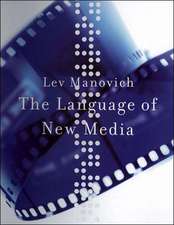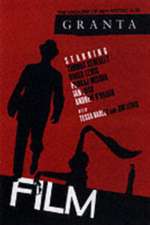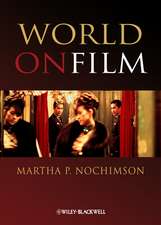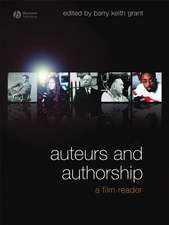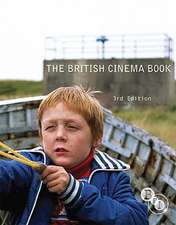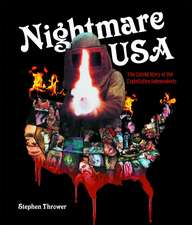A History of Artists' Film and Video in Britain
Autor David Curtisen Limba Engleză Paperback – apr 2006
| Toate formatele și edițiile | Preț | Express |
|---|---|---|
| Paperback (1) | 312.95 lei 3-5 săpt. | |
| British Film Institute – apr 2006 | 312.95 lei 3-5 săpt. | |
| Hardback (1) | 845.29 lei 3-5 săpt. | |
| BRITISH FILM INST % INDIA – 31 dec 2006 | 845.29 lei 3-5 săpt. |
Preț: 312.95 lei
Nou
Puncte Express: 469
Preț estimativ în valută:
59.89€ • 62.15$ • 50.06£
59.89€ • 62.15$ • 50.06£
Carte disponibilă
Livrare economică 22 februarie-08 martie
Preluare comenzi: 021 569.72.76
Specificații
ISBN-13: 9781844570966
ISBN-10: 1844570967
Pagini: 312
Dimensiuni: 155 x 235 x 21 mm
Greutate: 1.07 kg
Ediția:2006
Editura: British Film Institute
Colecția British Film Institute
Locul publicării:London, United Kingdom
ISBN-10: 1844570967
Pagini: 312
Dimensiuni: 155 x 235 x 21 mm
Greutate: 1.07 kg
Ediția:2006
Editura: British Film Institute
Colecția British Film Institute
Locul publicării:London, United Kingdom
Descriere
Bringing
to
light
the
range
and
diversity
of
British
artists
work
in
the
mediums
of
film
and
video,
Curtis
demonstrates
the
crucial
importance
of
the
moving
image
to
British
art
history.
Structured
in
two
parts
('Institutions'
and
'Artists
and
Movements'),
it
considers
the
work
of
some
300
artists,
including
Peter
Greenaway
and
Tracy
Emin.
Notă biografică
David
Curtis
is
Senior
Research
Fellow
at
the
AHRB
British
Artists'
Film
&
Video
Study
Collection,
Central
Saint
Martins,
University
of
the
Arts
London.
From
1977
to
2000
he
was
responsible
for
artists'
film
at
the
Arts
Council
of
Great
Britain.
In
2003-4
he
curated
Tate
Britain's
largest-ever
show
of
artists'
film
and
video,
A
Century
of
Artists'
Film
in
Britain.
He
was
involved
in
the
London
Filmmakers'
Co-op
in
the
late
1960s
and
ran
the
cinema
at
both
the
Drury
Lane
and
Robert
Street
(IRAT)
Arts
Laboratories.
His
book
Experimental
Cinema
(1970)
was
one
of
the
first
books
to
survey
the
international
film
avant-garde.
Textul de pe ultima copertă
In
recent
years
the
use
of
film
and
video
by
British
artists
has
come
to
widespread
public
attention.
Jeremy
Deller,
Douglas
Gordon,
Steve
McQueen
and
Gillian
Wearing
all
won
the
Turner
Prize
(in
2004,
1996,
1999
and
1997
respectively)
for
work
made
on
video.
This
fin-de-siecle
explosion
of
activity
represents
the
culmination
of
a
long
history
of
work
by
less
well-known
artists
and
experimental
film-makers.
Ever
since
the
invention
of
film
in
the
1890s,
artists
have
been
attracted
to
the
possibilities
of
working
with
moving
images,
whether
in
pursuit
of
visual
poetry,
the
exploration
of
the
art
form's
technical
challenges,
the
hope
of
political
impact,
or
the
desire
to
re-invigorate
such
time-honoured
subjects
as
portraiture
and
landscape.
Their
work
represents
an
alternative
history
to
that
of
commercial
cinema
in
Britain
-
a
tradition
that
has
been
only
intermittently
written
about
until
now.
This
major
new
book
is
the
first
comprehensive
history
of
artists'
film
and
video
in
Britain.
Structured
in
two
parts
('Institutions'
and
'Artists
and
Movements'),
it
considers
the
work
of
some
300
artists,
including
Kenneth
Macpherson,
Basil
Wright,
Len
Lye,
Humphrey
Jennings,
Margaret
Tait,
Jeff
Keen,
Carolee
Schneemann,
Yoko
Ono,
Malcolm
Le
Grice,
Peter
Gidal,
William
Raban,
Chris
Welsby,
David
Hall,
Tamara
Krikorian,
Sally
Potter,
Guy
Sherwin,
Lis
Rhodes,
Derek
Jarman,
David
Larcher,
Steve
Dwoskin,
James
Scott,
Peter
Wollen
and
Laura
Mulvey,
Peter
Greenaway,
Patrick
Keiller,
John
Smith,
Andrew
Stones,
Jaki
Irvine,
Tracy
Emin,
Dryden
Goodwin,
and
Stephanie
Smith
and
Ed
Stewart.
Written
by
the
leading
authority
in
the
field,
A
History
of
Artists'
Film
and
Video
in
Britain,
1897-2004
brings
to
light
the
range
and
diversity
of
British
artists'
work
in
these
mediums
as
well
as
the
artist-run
organisations
that
have
supported
the
art-form's
development.
In
so
doing
it
greatly
enlarges
the
scope
of
any
understanding
of
'British
cinema'
and
demonstrates
the
crucial
importance
of
the
moving
image
to
British
art
history.

